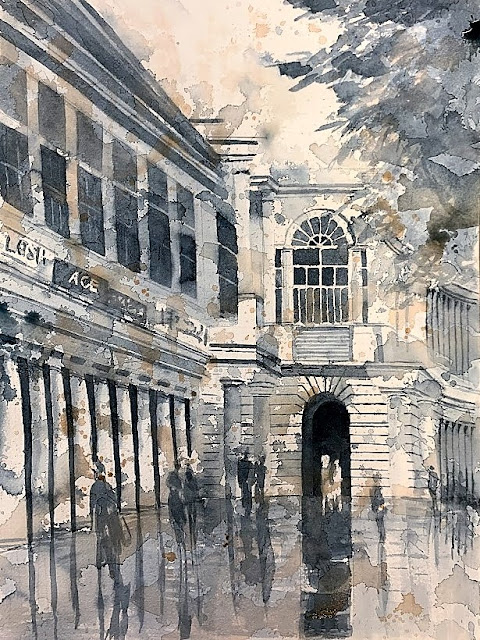Base and limits
I had a sudden realization the other day. The reason why limited palettes work is because there is harmony. Each color mix contains the two colors in varying proportions so there is always a base of the common color.
Understanding this base becomes more important when using various colors from different tubes. Harmony can still be achieved if you think of a common color as a base. Some artists will tint their entire paper with a light value of a single base color which creates automatic harmony because there is a common underlying layer, but that is not what I mean by base color (though that can be done, and yields pleasing results). What I mean is understanding the base - like a secret color - from the choices you are about to make. For example, if I know I will need a blue, green, and purple for my painting, I could use a pleasing blue, a favorite purple, and a lovely green. But what if they don't have the same base? There won't be harmony. So, start with a pleasing blue, create a purple by mixing any red with that pleasing blue (though the best most vivid purple will be with a red the same temperature as the blue - more on that another time), and a green by mixing a yellow with the same blue as base. The common base is then the same blue, even though the colors are different (and not directly from tubes), and there is harmony.
I was a little sloppy with this drawing, but there is color harmony for sure since it is just two colors. And glorious watermarks.
Understanding this base becomes more important when using various colors from different tubes. Harmony can still be achieved if you think of a common color as a base. Some artists will tint their entire paper with a light value of a single base color which creates automatic harmony because there is a common underlying layer, but that is not what I mean by base color (though that can be done, and yields pleasing results). What I mean is understanding the base - like a secret color - from the choices you are about to make. For example, if I know I will need a blue, green, and purple for my painting, I could use a pleasing blue, a favorite purple, and a lovely green. But what if they don't have the same base? There won't be harmony. So, start with a pleasing blue, create a purple by mixing any red with that pleasing blue (though the best most vivid purple will be with a red the same temperature as the blue - more on that another time), and a green by mixing a yellow with the same blue as base. The common base is then the same blue, even though the colors are different (and not directly from tubes), and there is harmony.
I was a little sloppy with this drawing, but there is color harmony for sure since it is just two colors. And glorious watermarks.




Comments
Post a Comment